Unprecedented fertility declines in South Korea. High immigration in Canada. An aging population in Cuba. A slow fertility decline in Côte d’Ivoire, according to U.S. Census
The U.S. Census Bureau produces population estimates and projections for over 200 countries and areas with populations of 5,000 or more that are publicly available on the International Database (IDB).
Today, the Census Bureau published revised estimates and projections for 34 countries or areas. The updates incorporate new population data and changes in demographic trends.
These population estimates and projections show population trends that are unique to some countries and others that represent broader global shifts. They also help the U.S. government and the public answer fundamental questions about the world’s people and places.
Today, the Census Bureau published revised estimates and projections for 34 countries or areas. The updates incorporate new population data and changes in demographic trends.
Below, we look at some of the changes the updates reveal:
South Korea
The global trend of declining fertility is at its most extreme in South Korea.
The updated data on South Korea shows that the country’s total fertility rate (TFR) in 2024 is an estimated 0.68.
The TFR measures the number of children a woman would have in her lifetime given current fertility rates; 2.1 is generally considered the level needed for long-term population replacement.
South Korea’s ultra-low level of fertility represents a 43% decline over 10 years from an already low level of 1.2 in 2014 (Figure 1). The country’s steep and rapid decline to ultra-low fertility is unprecedented and is much lower than previous projections.
Estimated and Projected Total Fertility Rate (TFR) in South Korea: 1990-2100
Our previous projections assumed that fertility in South Korea would stop decreasing and gradually increase. This assumption was based on stationary-population theories. But given the lack of evidence of a fertility rebound in recent years, our revised projections no longer assume this.
Our projection holds 2024 estimated fertility constant — a compromise because of uncertainty about which way the trends will go. On one hand, there is no precedent for fertility to go even lower. On the other, South Korea’s trend has been sharply downward since 2016. A constant projection represents a compromise between continued decline and a recovery to population replacement levels.
Population Trends and Aging
Despite decades of low fertility and minimal migration, South Korea’s population increased until as recently as 2020 due to growth in the population of older age groups, a short-term phenomenon known as population momentum.
South Korea’s population has been declining since 2020, but it is still more populous than it was a few decades ago. Its 2024 population is still 19% larger than in 1990. Despite projections of population declines for the foreseeable future, it is not expected to drop lower than it was in 1990 until 2055 (Figure 2).
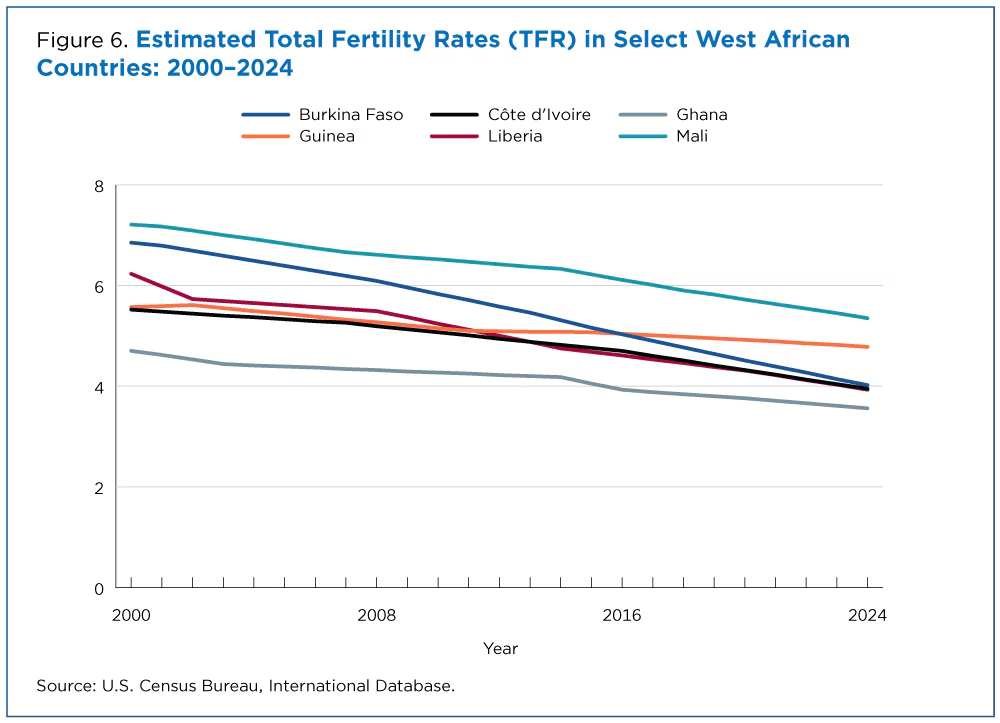
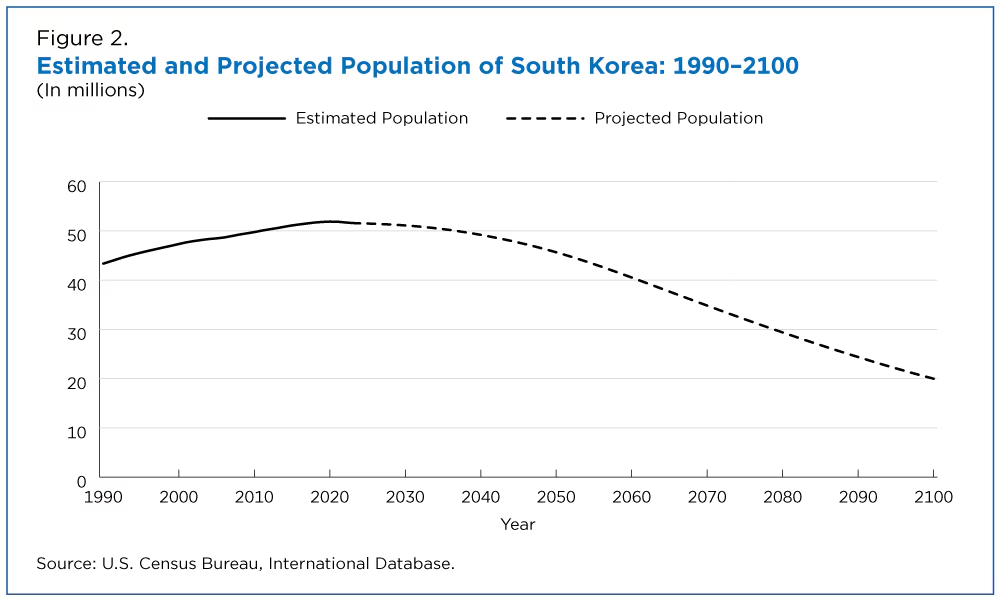
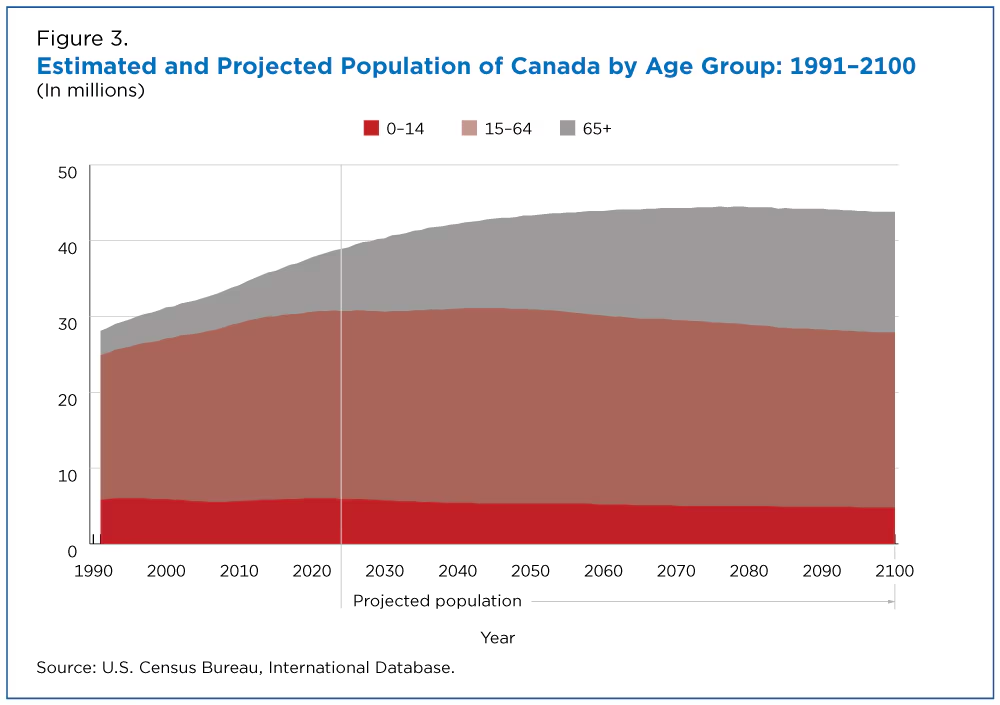
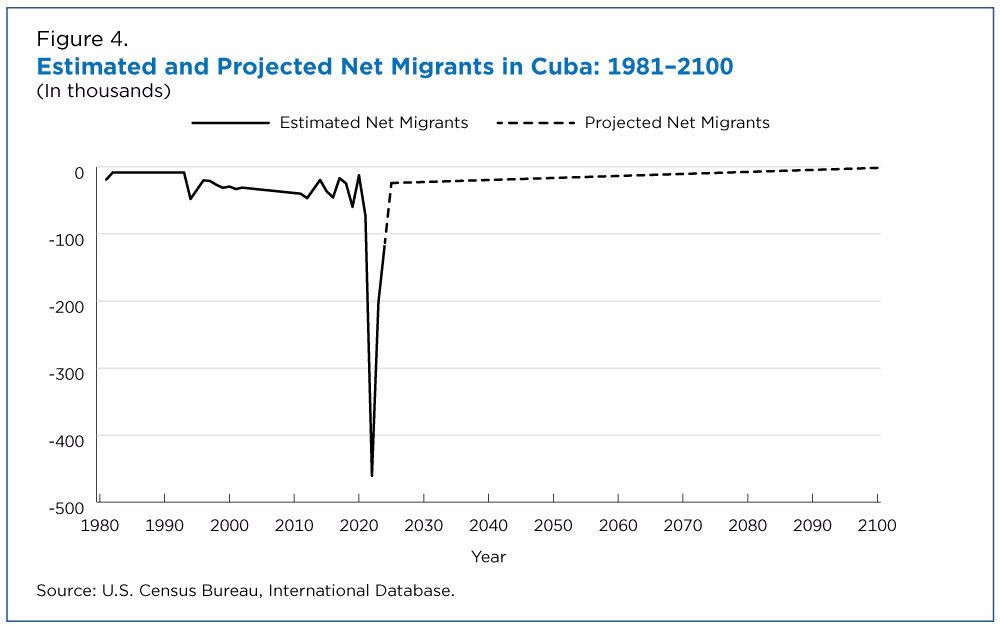
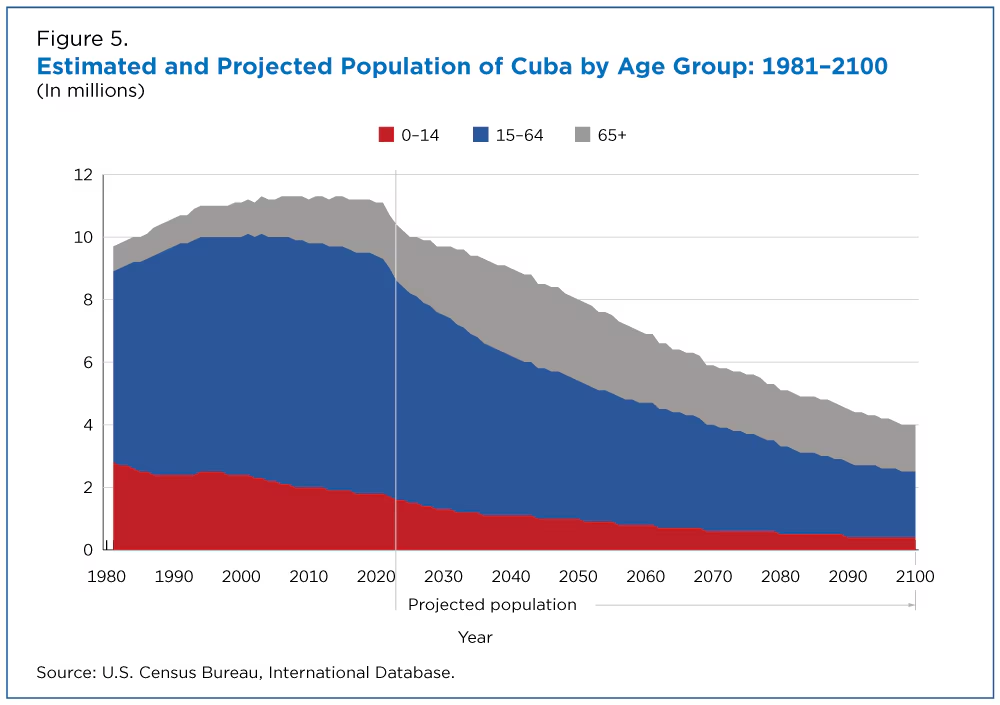

While South Korea’s population is returning to previously seen totals, it is doing so with an unprecedented proportion of its population at older ages. The proportion of South Korea’s population age 65 and older is on the rise and is projected to keep growing.
In 1990, about 2.2 million people (about 5% of the population) were age 65 or older. Thirty-four years later, that number has swelled to 10.2 million (20% of the population). And it’s projected that people age 65 and over will make up 50% of South Korea’s population by 2062.
Canada
Canada represents a country with high immigration compared to other countries.
Canada has had decades of high immigration. In 2024, the rate of net migration is 6.1 per thousand, meaning that about another six people are added to the population via migration for every 1,000 people in the population.
Between 1991 and 2024, Canada’s level of net migration fluctuated between 4 and 8 per thousand. The cumulative effect of decades of high immigration means that approximately 1 in 4 (23%) people in Canada in 2021 were immigrants, according to Statistics Canada.
Due to Canada’s consistent trend of relatively high immigration, we project high immigration to continue in the near future. However, migration is also the most difficult demographic component to project.
Migration is less dependent than mortality or fertility on the age of the population and can pivot suddenly and dramatically because of policy decisions, economic conditions and complex humanitarian crises.
Population Trends and Aging
Despite decades of low fertility, Canada’s population has been growing due to migration and an increase in the population age 65 and older, which more than doubled from about 3.2 million in 1991 to 8.2 million in 2024.
While the older population is expected to continue growing, the youngest population group (ages 0 to 14) is generally projected to decline through 2100.
As a result, Canada’s population will likely continue to age (Figure 3). The median age in 1991 was 33 (half the population was younger and half older). The median age today is 43.
The median age is projected to be 53 in 2077 when Canada’s population is projected to start declining.
Cuba
Like South Korea and Canada, Cuba has also had below-replacement fertility rates for decades. Cuba is unusual, however, because of its recent population exodus. This IDB update incorporates the latest data on the demographic trends unfolding in the island country.
An economic crisis sparked a massive outflow of people from Cuba in 2021. We estimate that Cuba lost approximately 7% of its population due to emigration between 2021 and 2023. Although emigration peaked in 2022, it remains relatively high.
Since emigration has been declining since its 2022 peak, we project that Cuba’s net migration will continue to fall back to its long-term trends of moderate emigration (Figure 4). This projection is, of course, uncertain.
Population Trends and Aging
Even before the recent exodus, Cuba’s population was already declining and aging. We estimate that Cuba’s population peaked in 2005.
The population decline was initially driven by moderate amounts of negative net migration (when more people leave than come into a country). Until recently, Cuba was still experiencing natural population growth from births outnumbering deaths.
But decades of low fertility have created an older population, and we estimate that deaths have outnumbered births in Cuba since 2020. Cuba is projected to have both negative natural population growth and negative net migration for the foreseeable future.
Cuba’s population is projected to decline quickly. Despite that, its population is still projected to be larger in 2030 than it was in 1981. The demographic novelty for Cuba — and other declining populations — is that population aging is inextricably tied to population decline.
As recently as the 1980s, people ages 0-14 outnumbered people age 65 and older by more than 3 to 1. Today, there are slightly more people age 65 and older than there are people ages 14 and younger. By 2100, we project there will be almost four people age 65 and older for every person age 14 and younger.
Côte d’Ivoire
The fertility rates in South Korea, Canada and Cuba declined faster than previously projected and we revised their fertility rates downward to incorporate new data. In the African country of Côte d’Ivoire, however, the fertility rate declined slower than previously projected, and we revised the fertility rate upward.
Estimated Fertility Trends and Projections
Côte d’Ivoire’s TFR in 2024 is estimated at 3.9, which is higher than was previously projected.
Côte d’Ivoire’s high level of fertility in 2024 shows a more gradual decline from very high levels of fertility, down 48% over the last 49 years from a TFR of 7.6 in 1975 to 3.9 in 2024.
This gradual decline is similar to the fertility picture in other countries in West Africa (Figure 6). We project fertility to continue to decline in Côte d’Ivoire and eventually reach a TFR of 2.1 in 2091.
Estimated Total Fertility Rates (TFR) in Select West African Countries: 2000-2024
Population trends and mortality
Côte d’Ivoire also has high infant mortality. The 2024 estimate was 53 infant deaths per every 1,000 live births. Such high infant mortality also means a low life expectancy at birth. The 2024 estimate for the life expectancy at birth was 63.5 years compared to 84.7 in South Korea, 83.9 in Canada and 78.4 in Cuba.
Although mortality in Côte d’Ivoire is higher relative to many other countries, its current levels are dramatic improvements from the past.
Life expectancy at birth increased by 14.4 years from 49.2 in 2000 to 63.5 in 2024. This represents an average increase of more than half a year every year since 2000. These improvements were fueled by rapid reductions in infant mortality and declines in AIDS mortality among adults.
We project the improvements in life-expectancy to continue but at a slower pace.
In combination with high fertility and declining mortality, Côte d’Ivoire’s population is growing. Its population doubled from 1998 to 31 million people in 2024 and we project it will double again over the next 38 years to 62 million by 2062.
The IDB, which provides estimates and projections of populations around the world to the year 2100, can help identify global demographic trends and show each country’s unique circumstances that may run counter to these trends.































Discussion about this post